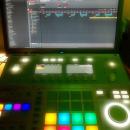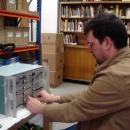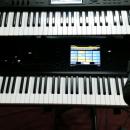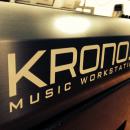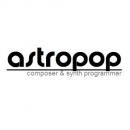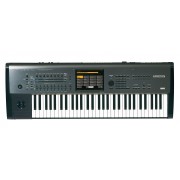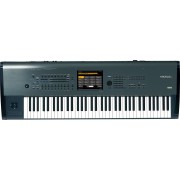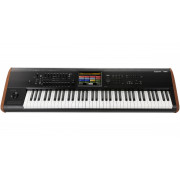Copiado de Korgforums:
New features in KRONOS software version 3.0
KRONOS software version 3.0 is a major upgrade, featuring the new SGX-2, system-wide touch-drag gestural input from the touch-screen, larger on-screen fonts, the ability to edit Programs in the context of Combinations and Songs, 12 vintage effects, and a raft of improvements to Set Lists.
There’s also a new Find feature for locating Programs and Combinations by name, audio level meters for Oscillators, Timbres, Tracks, and effects, improved support for non- equal-tempered scales, and support for editing text via USB alphanumeric keyboards. Last but not least, if a sound requires samples which aren’t currently loaded, you can now load those samples in a single step.
In addition to these new features, the update includes various improvements and resolutions to specific operational issues.
SGX-2
The updates to the SGX-1 are so significant that we thought it deserved an updated name as well—hence, the SGX-2. First, the SGX-2 now includes modeled String Resonance, for an even more realistic playing experience (older sounds will need to be edited manually to enable this feature). Under-the-hood changes also enable powerful new Piano Types with up to 12 velocity zones and dedicated Una Corda samples—such as those of the EXs17 Berlin D Piano.
Touch-drag gestural input
Throughout the KRONOS, you can now simply touch your finger to a parameter and drag on the display to change its value. This applies to all knobs, sliders, drawbars, and numeric parameters. You can also touch and drag to create and delete connections on the MS-20EX and MOD-7 patch panels.
Editing Programs from within a Combination or Song
You can now jump directly into the editing pages of a Program from within a Combination or Song—while still hearing all of the other Timbres or Tracks. Tweak a step sequencer pattern, for instance, or experiment with patch cables in the MS-20EX.
Vintage effects
The new Vintage effect category includes 12 effects based on the CX-3 and EP-1. Classics such as the Small Phase and Vox Wah are now available as insert, master, and total effects.
Set List improvements
Set Lists now support different colors for each Slot, to make them easier to distinguish quickly. Slots can now also be transposed individually.
You can make more room for comments by showing only 4 or 8 Slots at a time, or show 16 Slots so that you have the maximum number of sounds under your fingertips. A new Comment Panel, accessible by touching the comment area and swiping downwards, temporarily dedicates the entire screen to the comment. You can also choose different font sizes for each Slot’s comments, from small (to fit more text without scrolling) to ultra-large (for easy visibility).
Find
The new Find feature, accessed by a magnifying-glass- shaped button in most selection dialogs, lets you search for Programs, Combinations, and other data by name.
Meters
On-screen meters now show audio levels for Program Oscillators (on the Control Surface page), Combination Timbres, Song Tracks, insert effects, and the main output.
Improved scale support
A new Global parameter, Osc/Timbre/Track Transpose, determines how the Program Oscillator, Combination Timbre, and Song Track Transpose parameters interact with the Scale and Key. There are two options, each designed for a specific use-case.
If you are using non-equal-tempered scales and want to build parallel intervals (such as “fat fifths”) into your sounds, use the Works Within Scale (for harmonies) setting. If, on the other hand, you play in non-equal-tempered scales and transpose entire songs—to accommodate singers, for example—use the Transposes Scale option.
Load Required Samples
If a Program, Combination, or Song uses EXs, User Sample Bank, or Sampling Mode data which is not currently loaded, the Samples Not Loaded message appears at the top of the display. You can now use the Load required samples command to load all of the required samples in a single step.
USB alphanumeric keyboard support
Anywhere that you can enter text, you can now use a connected USB alphanumeric keyboard as an alternative to the touch-screen keyboard. A keyboard with the standard US “IBM PC” QWERTY layout is recommended.
Other improvements
Program banks I-A...F may now be configured as either HD-1or EXi.
------
Si es cierto finalmente no está nada mal, lo de poder editar programas desde los modos politímbricos ya es un grandísimo acierto, la utilidad de un buscador para programas, los vúmetros, que al parecer reflejan audio y no velocity como en el M3, los nuevos efectos disponibles en general... no sé, pinta muy bien, eso si, seguimos sin la mejora del secuenciador

Saludos.


